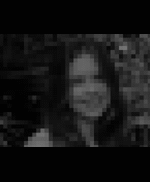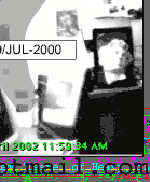

 |
|||||||||||||||||||||||||||||||
|
| |||||||||||||||||||||||||||||||
|
STATEMENT: "Self-Portrait v2.0 explores how we construct ourselves and, in turn, how we are perceived through data available online. Some data in cyberspace we consciously create to represent ourselves (emails and websites, for instance). Other bits of data accumulate without our efforts--and many times without our knowledge--tracing certain of our interactions both in the physical and virtual worlds. Because of this data we do not willingly disperse, our cyber image is not always in our control nor ever fully knowable to us. Self-Portrait v2.0 explores how we can be accessed online and what we may look like through mining digital data." (Brooke Singer) A subject's identity is often more fragile than we want to believe. It is the fruit of constant synthesis on the part of the subject, who recognizes himself as such in his actions and judgements and who can thus assemble them in an (ideally) coherent whole at every moment in his history. Identity therefore depends a great deal on the "persistence of memory" (to borrow from the title of a work by Dali). But we all have two memories, one conscious, the other unconscious, and the self the subject consciously constructs is often ignorant of much or all of the unconscious memory inscribed in him without his knowing it. In a self-portrait, whether visual or literary, the subject traditionally asks himself about this self with which he is supposed identify, either by seeking to represent himself for a moment outside this all-too-often misunderstood body that serves nonetheless as his interface in the world, or by trying to follow in an as coherent a narrative as possible the history that would be his own, such as his memory can bring it to mind. But too often indeed this self-portrait surprises or betrays the subject himself - for it is in any case a reconstruction and a representation, more or less coherent, more or less true. With Freud at the turn of the last century, psychoanalysis strove to know, and at the same time to make the subject recognize and accept, the other self which is the id, that is, the unconscious. But what of our "exterior" unconscious, so to speak, namely, those traces that we leave in the world through our actions and exchanges with others and which also serve to construct our identity? Do we not then have a third memory? Ever since the proliferation of personal computers in our lives, our physical and psychological memory has been aided, and sometime substituted, by a virtual memory that accumulates for us, often without our knowing it, data concerning us and resulting from our actions and exchanges. Constituting the imaginative world of another self, the reality of another unconscious and another personal history that are yet also ours, this virtual memory also constitutes a portrait of who we are. It's traces are no longer found in the body, but somewhere else, in a non-place, at once tangible (in hardware circuitry) and virtual (in the form of digital data), to the point where notions we have not only of the brain and memory, but of the body and of identity as well, borrow henceforth their metaphors from the world of computers. The computer comes to play a third term, both as interface and as filter between us and the world, at once as substitute for the body (with avatars, for example) and as substitute for memory. In addition, with the advent of the Internet and the interconnection of these virtual memories, something like a collective unconscious gradually emerges, a sort of non-place whose centre is everywhere and nowhere, where data concerning each of us is accessible to all, without our always knowing to what extent. It thus becomes possible for a third party to draw our portrait, outside of us, a portrait that is not only exterior, like the painted or photographic portrait, for instance, but often a very intimate and private portrait that eschews us. It is this paradoxical image of ourselves, at once private and public, that Singer attempts in some sense to reclaim and re-appropriate. On the one hand, she willingly and consciously makes available a large part of the data concerning her, like her e-mails, her geographic, economic, and even atmospheric situation, a webcam showing her at work, the sites visited, etc.; on the other, she searches the Net for information gathered about her by third parties (like the FBI, for instance, or polling companies), more or less without her knowledge, and makes this information available in her work. The visitor chooses among the topics provided and the "self-portrait" comes into shape on its own, stacking up layers, fragments of phrases, and images to visually represent the complex, yet always unique and instantaneous image of an on-line identity, moving, changing, impermanent - cleared, in fact, of the illusion of permanence and unity typical of the classical conception of the subject (Descartes and Kant) that psychoanalysis was the first to question. This "self-portrait" certainly speaks to us of Brooke Singer and represents her, but never entirely. What one learns from such an experience is that a portrait can never be complete, and identity is indeed an intersubjective construction.
Anne-Marie Boisvert
|
||||||||||||||||||||||||||||||

